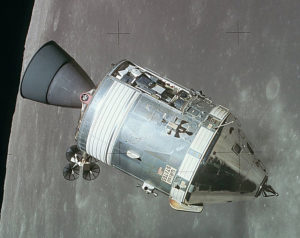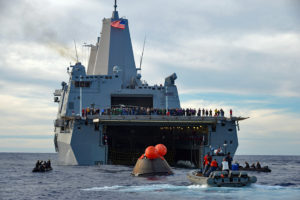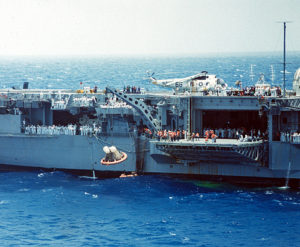It’s been 50 years since humans first travelled to the moon. The impact of that Apollo 8 mission continues to reverberate to this day. While orbiting the moon, astronaut Bill Anders took an iconic photo of the Earth rising over the lunar surface. This amazing photo has had a deep impact on humanity ever since, inspiring widespread environmental awareness and spawning many activities such as Earth Day.
Our nation’s manned space exploration community was very active and engaged from the Mercury program in 1961 through the end of the space shuttle program in 2011. The engine that ignited and drove this five decade flurry of activity was the Cold War between the Soviet Union and the United States. But the American spirit for exploration was the fuel that generated such great success. Our willingness to take steps into the unknown, and accepting the associated risks, culminated in the Apollo lunar landing and space shuttle programs. Both are technological feats that have yet to be matched by any other nation 50 years later!
Unfortunately, for the past few years, American progress in human space exploration has largely been stuck in the plan ning stages. The occasional flight to and from the Earth orbiting International Space Station (ISS) to swap astronauts is all that kept the “flight torch” shining brightly. Ironically, these flights were launched from, and landed in, Russia.
ning stages. The occasional flight to and from the Earth orbiting International Space Station (ISS) to swap astronauts is all that kept the “flight torch” shining brightly. Ironically, these flights were launched from, and landed in, Russia.
However, significant recent advances have been made by NASA and a number of private companies, such as SpaceX, Boeing, and Bigelow Aerospace.
In February, SpaceX launched its first Falcon Heavy rocket with an automobile-sized payload destined to arrive at Mars in the distant future. SpaceX has also garnered public attention with their Dragon spacecraft, which was designed to deliver both cargo and astronauts to the ISS. Dragon made history in 2012 when it became the first commercial spacecraft to deliver cargo to the ISS and return cargo back to Earth. SpaceX is now refining the spacecraft to enable it to safely carry humans to and from the ISS. The first manned test flight of Dragon may take place later this year.
But NASA has also been very busy the past few years too. They’ve created a blue print exploration program called Journey to Mars, with a goal of sending humans to the Red Planet in the 2030s. As part of this program, several autonomous orbiters, landers, and rover s have already landed on the surface of Mars, or are exploring it from Martian orbit. They have sent an amazing array of information back to scientists and researchers.
s have already landed on the surface of Mars, or are exploring it from Martian orbit. They have sent an amazing array of information back to scientists and researchers.
One of the critical components of the manned aspect of this program is the Orion multi-purpose crew vehicle (MPCV). Orion is the part of the spacecraft that holds up to six astronauts and research equipment, basically a bigger and more sophisticated version of the Apollo command modules. In the past four years, NASA subjected Orion to a battery of tests designed to ensure the spacecraft can safely ferry humans into orbit and on deep space missions.
Orion is designed with a heat shield that can withstand temperatures up to 5,000 degrees Fahrenheit as it reenters the atmosphere. Once the capsule slows from 25,000 miles an hour to “only” 300 miles an hour, it will deploy parachutes and splash down in the ocean where naval ships will be waiting for it.
After NASA’s first unmanned Orion orbital test flight in 2014 (known as EFT-1), a team of NASA and Navy specialists recovered the spaceship off the coast of San Diego, simulating what would happen when a deep space mission splashed down on Earth. The Navy ship used in the recovery was the USS Anchorage (LPD-23), an amphibious transport ship.
In late 2019, NASA plans to launch an unmanned Orion flight on its powerful new rocket, the Space Launch System, from the Kennedy Space Center in Florida. Exploration Mission 1 (known as EM-1), is slated to launch in December 2019, but that date could get pushed back into the following year.
This first mission will carry the unmanned spacecraft thousands of miles beyond the moon on a three week journey. Roughly two years later, astronauts will climb into an Orion capsule for a similar mission, traveling farther away from Earth than humans have ever traveled before.
Later in the 2020s, NASA is considering sending astronauts on a yearlong mission into this same deep space proving ground, verifying habitation and testing their readiness for a mission to Mars.
The USS Hornet Museum is one Bay Area institution that is very excited about the next decade of space travel. During the great moon race of the 1960s, all manned spaceflights ended by parachuting into the ocean. Water landings were not only safer than using land, but the weight of the capsule could be lessened, which is a critical success factor in rocketry. The space shuttle runway landings were fine for Earth orbit missions, but not suitable for deep space probing.
In July 1969, the WWII aircraft carrier Hornet gained worldwide fame when it recovered Apollo 11, the first lunar landing flight, which  splashed down in the Pacific Ocean. Millions of TV viewers around the world were spellbound as the three astronauts – Neil Armstrong, Buzz Aldrin, and Michael Collins, were hoisted into a helicopter and flown to the Hornet where President Nixon welcomed them back to Earth.
splashed down in the Pacific Ocean. Millions of TV viewers around the world were spellbound as the three astronauts – Neil Armstrong, Buzz Aldrin, and Michael Collins, were hoisted into a helicopter and flown to the Hornet where President Nixon welcomed them back to Earth.
The Hornet’s Apollo recovery exhibit is considered to be the best of its kind in the world. Thousands of space enthusiasts crowded its decks whenever an Apollo or shuttle astronaut was present.
With the upcoming missions to Mars, NASA and the Navy will again be teaming up to recover these spacecraft as they return from their epic journeys.
Once again, many thousands of space junkies, and families with young children, will walk the decks of the Hornet Museum, to gain insight and inspiration about the upcoming NASA programs to continue exploring our solar system.
Leave a Reply